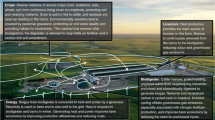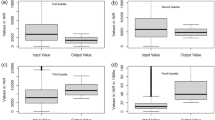Abstract
Agriculture is a major contributor to environmental degradation and climate change. At the same time, a growing human population with changing dietary preferences is driving ever increasing demand for food. The need for urgent reform of agriculture is widely recognized and has resulted in a number of ambitious plans. However, there is credible evidence to suggest that these are unlikely to meet the twin objectives of keeping the increase in global temperature within the target of 2.0 °C above preindustrial levels set out in the Paris Agreement and delivering global food security. Here, we discuss a series of technological options to bring about change in agriculture for delivering food security and providing multiple routes to the removal of CO2 from the atmosphere. These technologies include the use of silicate amendment of soils to sequester atmospheric CO2, agronomy technologies to increase soil organic carbon, and high-yielding resource-efficient crops to deliver increased agricultural yield, thus freeing land that is less suited for intensive cropping for land use practices that will further increase carbon storage. Such alternatives include less intensive regenerative agriculture, afforestation and bioenergy crops coupled with carbon capture and storage technologies.
This is a preview of subscription content, access via your institution
Access options
Access Nature and 54 other Nature Portfolio journals
Get Nature+, our best-value online-access subscription
$29.99 / 30 days
cancel any time
Subscribe to this journal
Receive 12 digital issues and online access to articles
$119.00 per year
only $9.92 per issue
Buy this article
- Purchase on Springer Link
- Instant access to full article PDF
Prices may be subject to local taxes which are calculated during checkout

Similar content being viewed by others
References
Shukla, P. R. et al. (eds) IPCC Special Report on Climate Change and Land (IPCC, 2019).
FAO, IFAD, UNICEF, WFP and WHO. The State of Food Security and Nutrition in the World 2017 (FAO, 2017).
Foley, J. A. et al. Solutions for a cultivated planet. Nature 478, 337–342 (2011).
Willett, W. et al. Food in the Anthropocene: the EAT-Lancet Commission on healthy diets from sustainable food systems. Lancet Comm. 393, 447–492 (2019).
Clark, M. A. et al. Global food system emissions could preclude achieving the 1.5° and 2 °C climate change targets. Science 370, 705–708 (2020).
Alexandratos, N. & Bruinsma, J. World Agriculture Towards 2030/2050: The 2012 Revision ESA Working Paper 12-03 (FAO, 2012).
Schmitz, C. et al. Land-use change trajectories up to 2050: insights from a global agro-economic model comparison. Agric. Econ. 45, 69–84 (2014).
Ray, D. K., Ramankutty, N., Mueller, N. D., West, P. C. & Foley, J. A. Recent patterns of crop yield growth and stagnation. Nat. Commun. 3, 1293 (2012).
Mueller, N. et al. Closing yield gaps through nutrient and water management. Nature 490, 254–257 (2012).
The State of Food and Agriculture 2019. Moving Forward on Food Loss and Waste Reduction (FAO, 2019).
Long, S. P., Marshall-Colon, A. & Zhu, X. G. Meeting the global food demand of the future by engineering crop photosynthesis and yield potential. Cell 161, 56–66 (2015).
Horton, P. We need radical change in how we produce and consume food. Food Security 9, 1323–1327 (2017).
Horton, P. et al. An agenda for integrated system-wide interdisciplinary agri-food research. Food Security 9, 195–210 (2017).
Bernacchi, C. J., Hollinger, S. E. & Meyers, T. The conversion of the corn/soybean ecosystem to no-till agriculture may result in a carbon sink. Glob. Change Biol. 11, 1867–1872 (2005).
Cabral, O. M. R. et al. The sustainability of a sugarcane plantation in Brazil assessed by the eddy covariance fluxes of greenhouse gases. Agric. Meteorol. 282, 107864 (2020).
Long, S. P. et al. in Bioenergy & Sustainability: Bridging the Gaps (eds Souza, G. M. et al.) 302–347 (SCOPE, 2015).
Harnessing Plants Initiative Salk Institute for Biological Science https://www.salk.edu/harnessing-plants-initiative (2020).
Paustian, K. et al. Climate-smart soils. Nature 532, 49–57 (2016).
Rumpel, C. et al. Put more carbon in soils to meet Paris climate pledges. Nature 564, 32–34 (2018).
Recarbonization of Global Soils (FAO, 2019); http://www.fao.org/3/ca6522en/CA6522EN.pdfhttp://www.fao.org/global-soil-partnership/resources/highlights/detail/en/c/1237415/
Kuiper, I., Lagendijk, E. L., Bloemberg, G. V. & Lugtenberg, B. J. J. Rhizoremediation: a beneficial plant–microbe interaction. Mol. Plant Microbe Interact. 17, 6–15 (2004).
Exposito, R. G., de Bruijn, I., Postma, J. & Raaijmakers, J. M. Current insights into the role of rhizosphere bacteria in disease suppressive soils. Front. Microbiol. 8, 12 (2017).
Oldroyd, G. E. D. & Leyser, O. A plant’s diet, surviving in a variable nutrient environment. Science 368, eaba0196 (2020).
Hartmann, J. et al. Enhanced chemical weathering as a geoengineering strategy to reduce atmospheric carbon dioxide, supply nutrients, and mitigate ocean acidification. Rev. Geophys. 51, 113–149 (2013).
Kantola, I. B. et al. Potential of global croplands and bioenergy crops for climate change mitigation through deployment for enhanced weathering. Biol. Lett. 13, 20160714 (2017).
Beerling, D. J. et al. Farming with crops and rocks to address climate, food and soil security. Nat. Plants 4, 138–147 (2018).
Beerling, D. J. et al. Potential for large-scale CO2 removal via enhanced rock weathering with croplands. Nature 583, 242–248 (2020).
Renforth, P. & Henderson, G. Assessing ocean alkalinity for carbon sequestration. Rev. Geophys. 55, 636–674 (2017).
Haque, F., Santos, R. M. & Chiang, Y. W. Optimizing inorganic carbon sequestration and crop yield with wollastonite soil amendment in a microplot study. Front. Plant Sci. 11, 1012 (2020).
Haque, F. et al. Co-benefits of wollastonite weathering in agriculture: CO2 sequestration and promoted plant growth. ACS Omega 4, 1425–1433 (2019).
Haque, F. et al. CO2 sequestration by wollastonite-amended agricultural soils—an Ontario field study. Int. J. Greenh. Gas Control 97, 103017 (2020).
Kelland, M. E. et al. Increased yield and CO2 sequestration potential with the C4 cereal Sorghum bicolor cultivated in basaltic rock dust-amended agricultural soil. Glob. Change Biol. 26, 3658–3676 (2020).
Lehmann, J. & Possinger, A. Atmospheric CO2 removed by rock weathering. Nature 583, 204–205 (2020).
Murchie, E. H., Pinto, M. & Horton, P. Agriculture and the new challenges for photosynthesis research. N. Phytol. 181, 532–552 (2009).
Zhu, X. G., Long, S. P. & Ort, D. R. Improving photosynthetic efficiency for greater yield. Annu. Rev. Plant Biol. 61, 235–261 (2010).
Kromdijk, J. et al. Improving photosynthesis and crop productivity by accelerating recovery from photoprotection. Science 354, 857–861 (2016).
South, P. F., Cavanagh, A. P., Liu, H. W. & Ort, D. R. Synthetic glycolate metabolism pathways stimulate crop growth and productivity in the field. Science 363, eaat9007 (2019).
Lopez-Calcagno, P. E. et al. Stimulating photosynthetic processes increases productivity and water use efficiency in the field. Nat. Plants 6, 1054–1063 (2020).
Yoon, D.-K. et al. Transgenic rice overproducing Rubisco exhibits increased yields with improved nitrogen-use efficiency in an experimental paddy field. Nat. Food 1, 134–139 (2020).
Kohler, I. H. et al. Expression of cyanobacterial FBP/SBPase in soybean prevents yield depression under future climate conditions. J. Exp. Bot. 68, 715–726 (2017).
Ort, D. R. & Long, S. P. Limits on yields in the corn belt. Science 344, 483–484 (2014).
Leakey, A. D. B. et al. Water use efficiency as a constraint and target for improving the resilience and productivity of C3 and C4 crops. Annu. Rev. Plant Biol. 70, 781–808 (2019).
Glowacka, K. et al. Photosystem II Subunit S overexpression increases the efficiency of water use in a field-grown crop. Nat. Commun. 9, 868 (2018).
Dunn, J. et al. Reduced stomatal density in bread wheat leads to increased water-use efficiency. J. Exp. Bot. 70, 4737–4748 (2019).
McAusland, L. et al. Effects of kinetics of light-induced stomatal responses on photosynthesis and water-use efficiency. N. Phytol. 211, 1209–1220 (2016).
Papanatsiou, M. et al. Optogenetic manipulation of stomatal kinetics improves carbon assimilation, water use, and growth. Science 363, 1456–1459 (2019).
Banwart, S. A. et al. Soil functions: connecting Earth’s critical zone. Annu. Rev. Earth Planet. Sci. 47, 333–359 (2019).
Goucher, L., Bruce, R., Cameron, D., Koh, S. C. L. & Horton, P. Environmental impact of fertiliser embodied in a wheat-to-bread supply chain. Nat. Plants 3, 17012 (2017).
Mus, F. et al. Symbiotic nitrogen fixation and the challenges to its extension to nonlegumes. Appl. Environ. Microbiol. 82, 3698–3710 (2016).
Wu, K. et al. Enhanced sustainable green revolution yield via nitrogen-responsive chromatin modulation in rice. Science 367, eaaz2046 (2020).
Bechar, A. & Vigneault, C. Agricultural robots for field operations: concepts and components. Biosyst. Eng. 149, 94–111 (2016).
Thurow, R. The Last Hunger Season: A Year in an African Farm Community of the Brink of Change (Public Affairs Press, 2013).
Stevenson, J. R. et al. Green Revolution research saved an estimated 18 to 27 million hectares from being brought into agricultural production. Proc. Natl Acad. Sci. USA 110, 8363–8368 (2013).
Roe, S. et al. Contribution of the land sector to a 1.5 °C world. Nat. Clim. Change 9, 817–828 (2019).
Griscom, B. W. et al. Natural climate solutions. Proc. Natl Acad. Sci. USA 114, 11645–11650 (2017).
Bossio, D. A. et al. The role of soils in natural climate solutions. Nat. Sustain. 3, 391–398 (2020).
Folberth, C. et al. The global cropland-sparing potential of high-yield farming. Nat. Sustain. 3, 281–289 (2020).
Food and Agriculture Data (FAO, 2020); http://faostat3.fao.org/home/E
Perino, A. et al. Rewinding complex ecosystems. Science 364, eaav5570 (2019).
Field, J. L. et al. Robust paths to net greenhouse gas mitigation and negative emissions via advanced biofuels. Proc. Natl Acad. Sci. USA 117, 21968–21977 (2020).
Lewis, S. L., Wheeler, C. E., Mitchard, E. T. A. & Koch, A. Regenerate natural forests to store carbon. Nature 568, 25–28 (2019).
Anderegg, W. R. L. et al. Climate-driven risks to the climate mitigation potential of forests. Science 368, eaaz7005 (2020).
Poulton, P. R., Pye, E., Hargreaves, P. R. & Jenkinson, D. S. Accumulation of carbon and nitrogen by old arable land reverting to woodland. Glob. Change Biol. 9, 942–955 (2003).
Hudiburg, T. W., Davis, S. C., Parton, W. & Delucia, E. H. Bioenergy crop greenhouse gas mitigation potential under a range of management practices. Glob. Change Biol. Bioenergy 7, 366–374 (2015).
Smith, P. et al. How much land-based greenhouse gas mitigation can be achieved without compromising food security and environmental goals? Glob. Change Biol. 19, 2285–2302 (2013).
Acknowledgements
D.J.B. and S.A.B. acknowledge funding from the Leverhulme Trust through a Leverhulme Research Centre Award (RC-2015-029). S.P.L. acknowledges funding from the DOE Center for Advanced Bioenergy and Bioproducts Innovation (US Department of Energy, Office of Science, Office of Biological and Environmental Research under award number DE-SC0018420). The input of P.S. contributes to the DEVIL (NE/M021327/1) and Soils‐R‐GRREAT (NE/P019455/1) projects.
Author information
Authors and Affiliations
Contributions
P.H., S.P.L., P.S., S.A.B. and D.J.B. wrote the paper.
Corresponding author
Ethics declarations
Competing interests
The authors declare no competing interests.
Additional information
Publisher’s note Springer Nature remains neutral with regard to jurisdictional claims in published maps and institutional affiliations.
Rights and permissions
About this article
Cite this article
Horton, P., Long, S.P., Smith, P. et al. Technologies to deliver food and climate security through agriculture. Nat. Plants 7, 250–255 (2021). https://doi.org/10.1038/s41477-021-00877-2
Received:
Accepted:
Published:
Issue Date:
DOI: https://doi.org/10.1038/s41477-021-00877-2
This article is cited by
-
Suppressing ASPARTIC PROTEASE 1 prolongs photosynthesis and increases wheat grain weight
Nature Plants (2023)
-
Circular economy and agriculture: mapping scientific productivity, research pattern and future research direction
Environment, Development and Sustainability (2023)
-
Harnessing Phyllosphere Microbiome for Improving Soil Fertility, Crop Production, and Environmental Sustainability
Journal of Soil Science and Plant Nutrition (2023)
-
Biochar application in remediating salt-affected soil to achieve carbon neutrality and abate climate change
Biochar (2023)
-
Review: biological engineering for nature-based climate solutions
Journal of Biological Engineering (2022)



